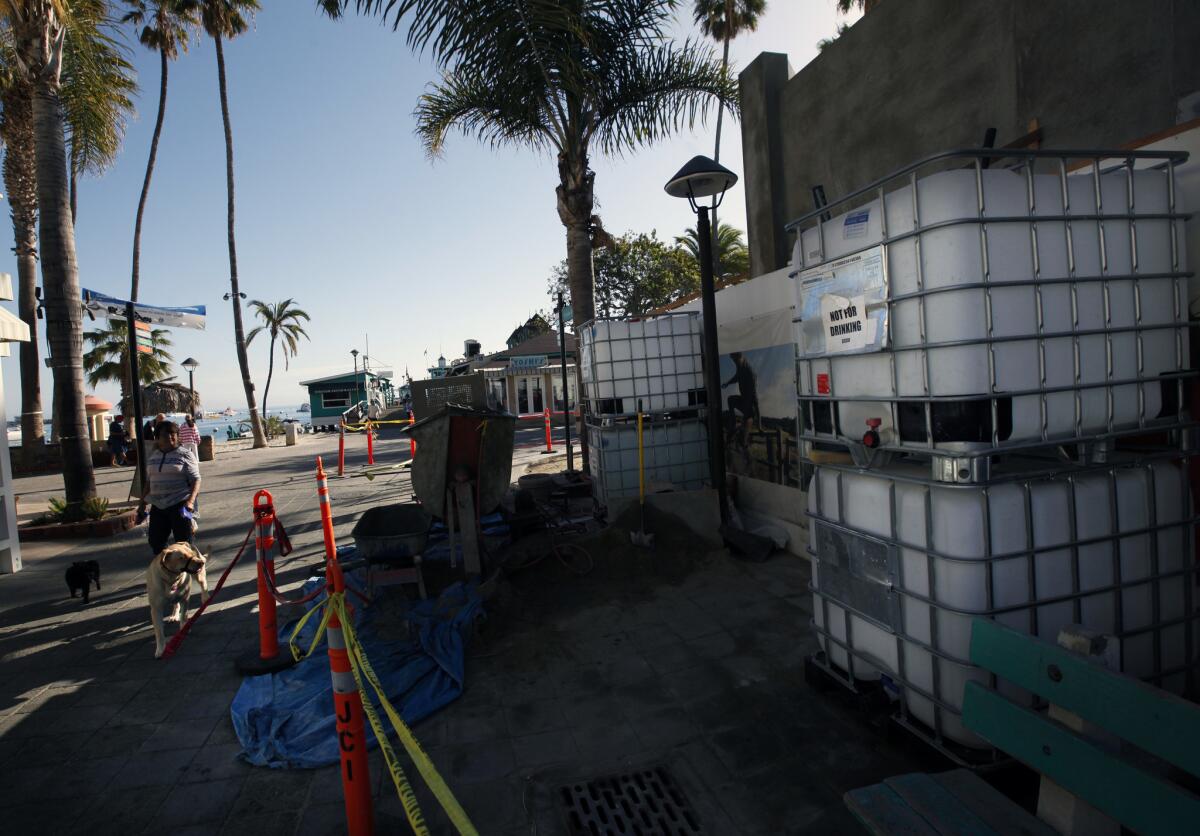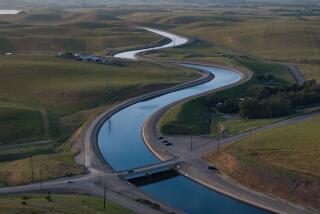Building boom and drought collide on Catalina Island

- Share via
Reporting from AVALON, SANTA CATALINA — Signs of drought and anxiety are everywhere in this quaint harbor town.
Hotels are shipping laundry to the mainland for washing, contractors are mixing cement with water they import by barge and residents are squaring off with developers over choices between rationing and curbing growth.
The disputes are fraught with competing concerns because Catalina’s economy depends heavily on visitors. The island, 22 miles offshore, is in the midst of a building boom intended to revive a flagging tourism industry.
Kevin Strege, who owns a vacation lodging company here, pleaded with Avalon City Council members at a recent meeting to take steps that would help businesses keep operating.
“I beg you, this problem has got to be fixed because my life and the life of my family and the lives of my employees depend on the decisions you guys make,” Strege said. “We’re scared.”
Avalon currently operates under Stage 2 rationing guidelines, which call for the island’s 2,200 ratepayers to reduce water consumption by 25% and bans washing of streets, parking lots and driveways. Islanders have responded by cutting water draws by 30%.
Despite those cuts, Southern California Edison, the island’s water utility, plans to impose Stage 3 restrictions in October. They would require ratepayers to slice water use by 50% or face penalties on their monthly bills.
Under Stage 3 restrictions, even the best restaurants will use paper plates to avoid washing dishes, construction projects will be put on hold, and hotels say they will be forced to close laundry services and shutter rooms, triggering layoffs in a town where many residents work two and three jobs to make ends meet.
The restrictions also would shave 10% off revenues for the city’s $24-million budget as hotel bed taxes, wharfage fees and sales taxes decline, City Manager Ben Harvey said.
“Drought has a trickle-down effect on everything we do on an island where water has to come from the sky, by barge or from a desalination plant,” Harvey said.
City Councilman Joe Sampson was more blunt. “If we go to Stage 3, things will get ugly,” Sampson aid. “People are in an uproar.”
That’s because successive years of water rationing are wearing at the nerves of residents. Many limit their showers to three minutes, yet they see new attractions beckoning tourists with little apparent regard for water conservation. The newly opened Spa at Catalina, for instance, boasts of “private showers for two in each treatment room.”
At contentious City Council meetings, homeowners question the construction of new visitor attractions and proposals to construct more desalination plants, whose costs would be passed on to customers who already pay higher rates than mainlanders. Business owners accuse the city of not being aggressive enough in seeking grants that could offset drought-related costs and of delaying approval of building permits.
“Instead, our city officials argue and throw up roadblocks to solutions,” Strege said. “They’re not out there protecting our interests.”
A proposal to build a Vons grocery, which would be Avalon’s first full-scale supermarket, is drawing criticism because the Catalina Island Co., which owns all the developable land on the 75-square-mile island, plans to transfer some of its water allocations to the project.
The City Council plans to make a decision on the project in August, around the time the island’s 4,500 year-round residents will be preparing for Stage 3 rationing.
Water disputes have delayed completion of the new $9-million Ada Blanche Wrigley Schreiner Building of the Catalina Island Museum, an attraction the island hopes will boost tourism. Council members say that before it opens, the museum must prove that its water use — including eight bathroom sinks — will not exceed its permitted allocations or violate local laws enacted to conserve water.
That won’t be easy. A city ordinance bans water hookups at new construction projects until Stage 2, 3 or 4 water rationing is lifted.
“I want to see that museum open,” Councilwoman Cinde MacGugan-Cassidy said. “But not at the cost of everyone else having to take three-minute showers and families not having enough drinking water.”
Inland from Avalon, Geoffrey Rusack, and his wife, Alison Wrigley Rusack, a great-granddaughter of chewing-gum magnate William Wrigley Jr., who bought Santa Catalina Island Co. in 1919, are defending their use of private water rights acquired in 1962 to irrigate the island’s first vineyard.
Councilman Sampson questions the use of water drawn from local aquifers to irrigate what he described as a “luxury vineyard that is not benefiting Avalon at all.”
The Rusacks are experimenting with cultivation techniques that use far less water than the roughly 1.2 million gallons now used for their island vintages each year.
Seeking a long-term answer to the island’s plight, Edison and the Island Co. are collaborating on potential solutions that include drilling for water in bedrock hundreds of feet beneath Avalon’s golf course and buying or leasing portable desalination plants, which would require state permits because they would dump hazardous brine offshore.
Edison’s existing water system is a complicated relic of old pumps, tanks and miles of 10-inch pipelines crisscrossing rugged canyon lands. A desalination plant provides about 80% of the roughly 250,000 gallons of water consumed on the island each day during the slow winter months, with the rest coming from groundwater aquifers, officials said.
In the summer, when the island accommodates up to 8,000 visitors per day, Edison relies mostly on groundwater pumped from an aquifer connected to the island’s largest reservoir, Thompson Reservoir.
Under California Public Utilities Commission guidelines, Stage 2 rationing is imposed when the reservoir drops below 300 acre-feet. Stage 3 begins when the reservoir falls below 200 acre-feet.
With water scarce, contractors have been mixing cement with potable Colorado River water bought from the Los Angeles Department of Water and Power. When asked by The Times why they are using drinkable water instead of DWP recycled water, which is available for construction at lower cost, contractors said they would were not aware of the recycled-water option.
DWP dispenses the Colorado River water from a fire hydrant in Wilmington. Barges ferry the water to Catalina in 275-gallon plastic totes tagged with signs that warn, incorrectly: Not For Drinking.
The Island Co., which is building a clothing store in town, and Mike Flynn, who is developing the new museum, said the DWP never mentioned the availability of recycled water.
Asked if the utility had failed to tell the Catalina contractors about recycled water, Michelle Figueroa, a spokeswoman for the DWP, said, “That can be true.”
The DWP can provide recycled water if asked, Figueroa said.
More to Read
Sign up for Essential California
The most important California stories and recommendations in your inbox every morning.
You may occasionally receive promotional content from the Los Angeles Times.











